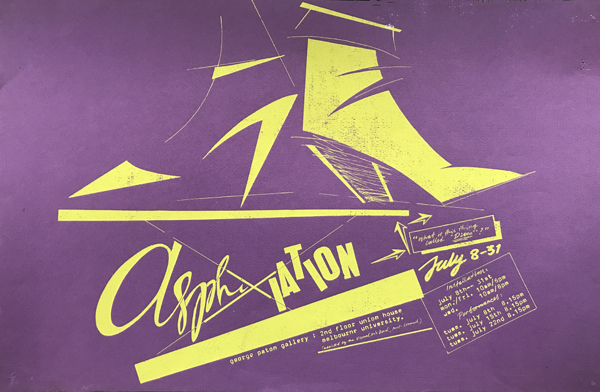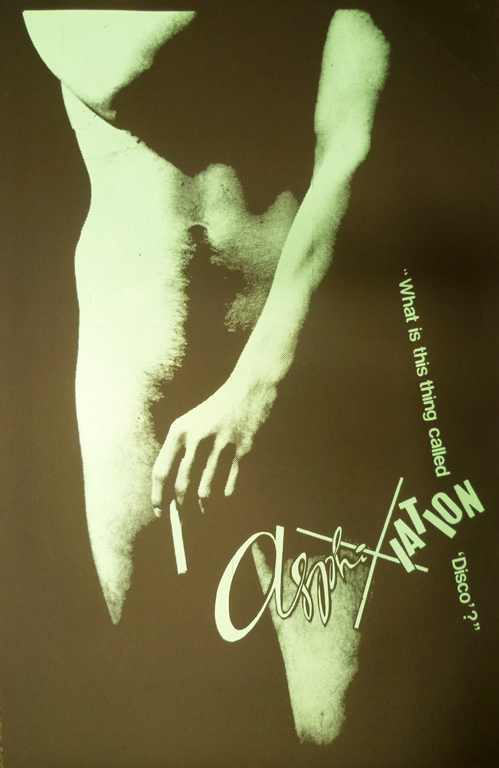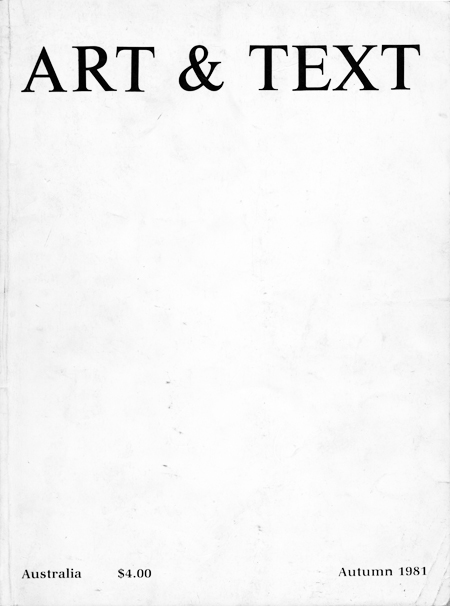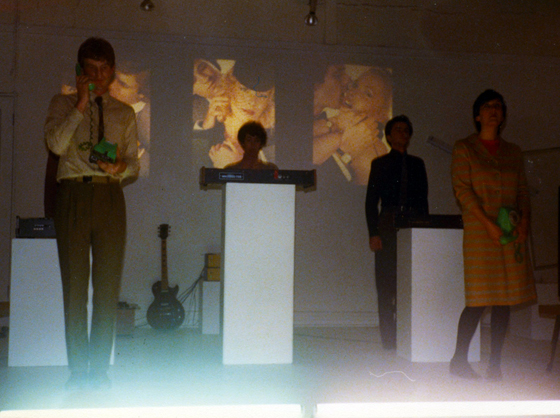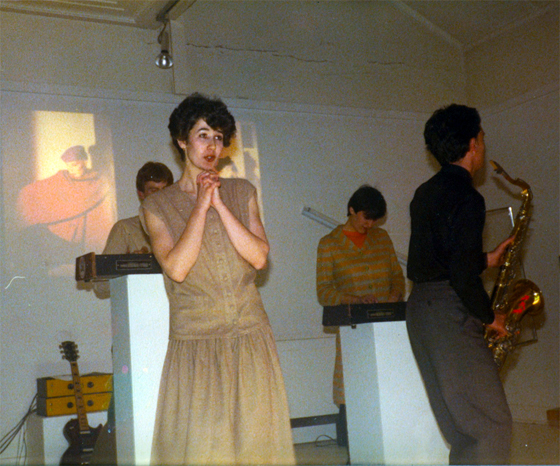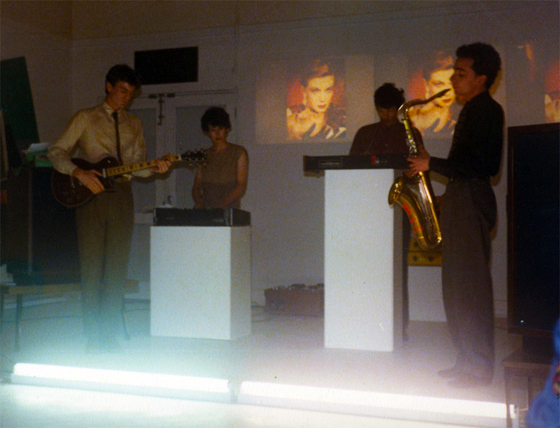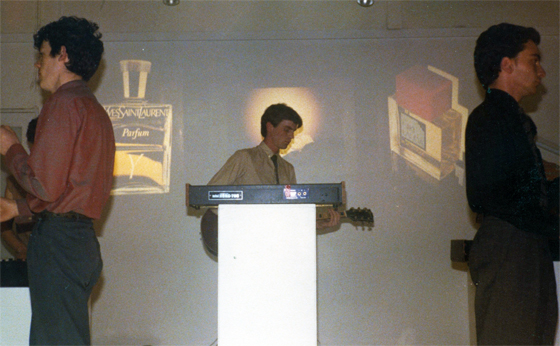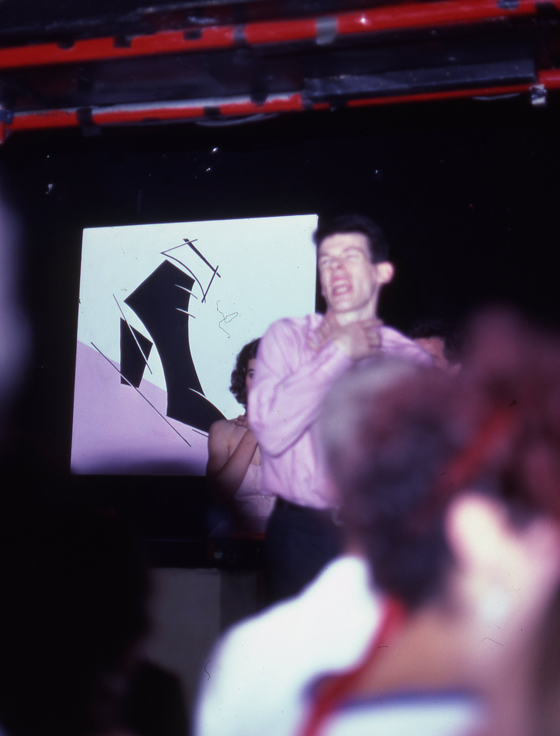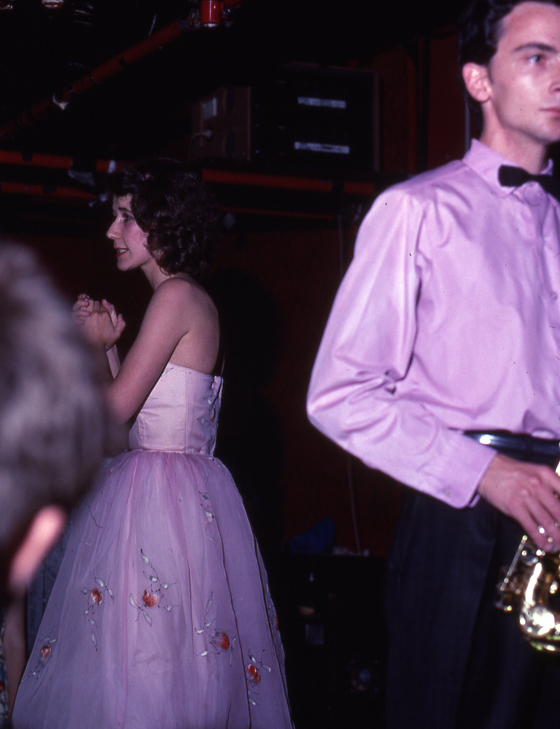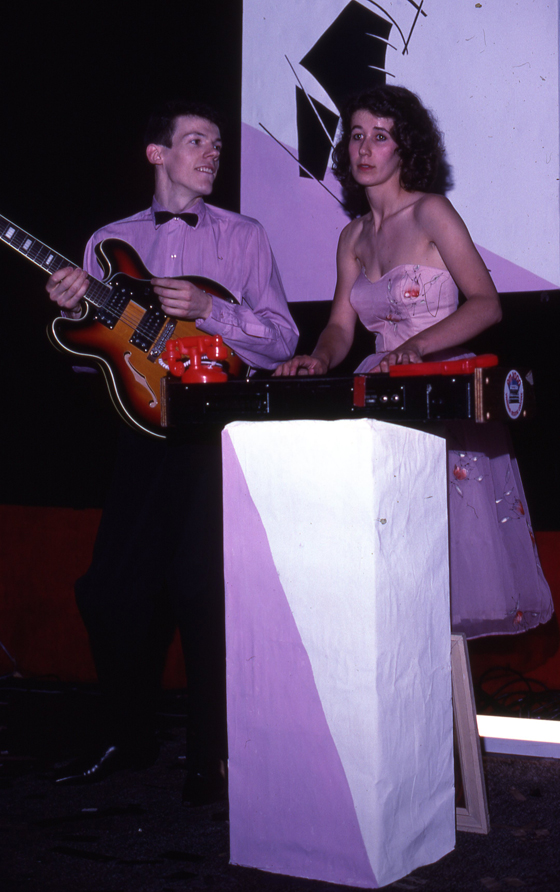Reviews
Asphixiation: "What is this thing called 'Disco'?"
published in Mutant Sounds October 31st, Texas © 2010
by vdoandsound
A side project of Australia's Philip Brophy, better known for his long running unit → ↑ → (pronounced tsk tsk tsk), this flabbergasting marvel does it's damnedest to wriggle free of tidy explanations. What's being proposed here is a species of mutated and horn-riddled avant electro-funk, but one that's being perverted in the most subtle and slippery ways imaginable, with the sonics here situated (to my ears at least) somewhere between B.E.F., Hajime Tachibana and Ralph Carney's work on Bowling Balls From Hell. 100% irresistible.
Asphixiation: "What is this thing called 'Disco'?"
published in SF Sonic June 1st, San Francisco © 2017
by John-Paul Shiver
Melbourne, Australian provocateur Philip Brophy, best known for his work with → ↑ → (pronounced with three clicks of the tongue), whose decade-long investigation into the aesthetics of punk and electronic and dance music began in the late 1970s created a fake disco band, Asphixiation, that played at Melbourne University’s George Paton Gallery in July of 1980. The ensuing exhibition presented paintings lifted from Italian Vogue, single instruments displayed on plinths, tape loops playing minimalist ambient sounds, and a synthesizer pulsing a loud thump throughout the space.
“What Is This Thing Called ‘Disco’?,” a 12-track no-wave/disco/not disco record that accompanied the installation, should be regarded as a classical feat, reflective of the emerging sounds at that time. It encapsulates the downward descent of “mainstream” disco and the uprising of new wave and post-punk, while borrowing certain elements from other dance-floor genres. There is an unruffled confidence and invisible seduction that runs through the locked groove of “Aural Risk.” The play between saxophone and xylophone lines coupled with gentle vocal musings by Maria Kozic and Jayne Steven make the song worthy of being placed someplace between the original Was Not Was project and the early incarnations of Kid Creole and The Coconuts. Essentially this 12 inch could be from the landmark Ze Records imprint from 1980.
The swirling horns and ethereal atmospherics of the instrumental opener “The Beat Aesthetic” or the quirky electronic musings that provides a back round to the hushed lyrics of “Feelings”…both selections call attention to a dissimilar appropriation of musical identities. That sonic duality theory continues further with “Innocent Rhythms.” A sonic confluence of Phillip Glass brainiac minimalism meeting the industrial strife of the band Suicide. Or the upright synth stomp of “The Crush,” which borrows a disco 4/4 bombast and matches it with a wonky keyboard line repeated ad infinitum.
Asphixiation: "What is this thing called 'Disco'?"
published on Boomkat Manchester UK © 2017
Necessary reissue of a belting art-disco / post-punk confection from Asphyxiation - an ersatz disco band created by Brophy and a gaggle of naif young pals working within the fairly feral and unrestrained art and culture channels of late ‘70s Australia, where they gleefully messed around with the conventions and presentation of what was then a putatively frivolous phenomenon.
Organised under a playfully sardonic title, “What Is This Thing Called ‘Disco’?” was presented as installation at Melbourne University’s George Paton Gallery in the form of six cubicles displaying single instruments (sax, guitar, microphone) on plinths behind gilded frames and paintings lifted from Italian Vogue, each with a minimal ambient tape loop accompaniment and all united by a speaker playing a thumping kick drum, in effect offering a clinical dissection of disco which accentuated or exaggerated its artificial nature with tongue firmly in cheek, properly toying with the notion of disco as “not real music” - remember this is 1980 when disco was often a dirty word.
The exhibition was completed by a live performance by the “fake” disco band, Asphyxiation, who mimed to tracks played from a reel-to-reel, in effect cementing and highlighting the perceived “fakeness” of it all while smartly playing into and subverting art convention. Those tracks are now presented here in their entirety along with a bonus 12” cut for the DJs included with the original 1981 release. Far from anything abstract or “challenging” in an abrasive sense, the tracks are gleefully driven and playful, each taking on a certain sub-genre of disco with a totally charming blend of genuine passion for the sound, and a knowledge of how it would be received by punk/post-punk and gallery audiences.
There are some real nuggets inside, none more so than the giddy, Moroder-esque Tradition Europe with its wobbling LFOs and sweeping FX, or the mad Patrick Cowley/ proto-Drexciyan styles of African Disco Queen, and the weirdly melancholic hustle of Innocent Rhythms. But there’s also a real diversity elsewhere running to blunted reggae disco with downpitched vox on Asphyxiation, and some really wayward beauties in the pealing sax and synth experiment The Beat Aesthetic, or their droll, grubbing boogie Self Denial (Is A Beautiful Thing).
And even more unmissable for the DJs, the bonus 12” is cut louder, prouder with two charms in the perky pink disco-punk bump of L’Acrostique D’Amour and The Crush, which you could easily imagine Jamal Moss or Jon K flinging into a set.
Asphixiation: "What is this thing called 'Disco'?"
published on Cyclic Defrost Melbourne © 2017
by Bob Baker Fish
If it wasn’t 1981, and was instead 2017 it’s hard to imagine how Asphixiation’s music could be any different. It’s possibly because these days one of the quickest ways to garner credibility is to use (and fetishise) many of the exact synthesizers that created this album. Though there are links too in the form, in the structures of the music too, perhaps again also due to the hardware.
This kind of lost Australian synth artefact should have an incredible backstory of lost tapes and tireless investigation, yet it’s not the case, it doesn’t need to be. The reality is that Australia doesn’t seem to value its culture that much, and either we never knew about Asphixiation or simply forgot.
Perhaps its understandable, as it came out of the post punk experimental netherworld of 1981, a one off project by a 20 year old Melbourne artist Phillip Brophy, better known as part of → ↑ → (pronounced with three clicks of the tongue). He apparently wrote the music in 5 days, these drawn out komische style electronic jams that draw on everything from Yellow Magic Orchestra to Giorgio Moroder. With → ↑ → members Ralph Traviato writing lyrics, and Leigh Parkhill on guitar and vocals shared between all members,including visual artists Maria Kozic and Jayne Stevenson, their recordings were done over 7 graveyard sessions at Latrobe University studios, engineered by David Chesworth (Essendon Airport) and Chris Wyatt.
The results are this unique form of mutant art disco funk, a raw edgy yet deceptively diverse collection of electronic music.
The tone varies, often the vocals are coy or downright silly, such as ‘Self Denial’ which begins with the words “I have a list of many things that I intend to never do,” and lauds the beauty of self denial. Or ‘The Crush’ which is cloying with the chanting of the word ‘crush’ over squiggly synth runs, a repetitive baseline and female vocals annoyingly detailing the object of her crush. It’s quite cheeky and comes off a little gimmicky, demonstrating that they weren’t taking themselves too seriously. There are links here to fellow Melbourne synth enthusiasists The Metronomes who also periodically tinkered with quirky vocal humour.
The instrumental pieces tend to be more atmospheric, more overtly funky, yet still possessing an experimental playful feel. It’s this combination that makes this collection so impressive as you try to get a bead on what Asphixiation were on about. One moment they sound like A Certain Ratio, the next The Flying Lizards. There’s no doubt Brophy et al were playing around with the perceived artificiality of electronic music, yet they were doing it with such humour and inventiveness that it not only holds up some 36 years later, but it feels criminal that they didn’t become household names. It’s another great missive from Australia’s forgotten electronic past.
Asphixiation: "What is this thing called 'Disco'?"
published in The Age July 16th, Melbourne © 1980
by Robert Rooney
The flash and tinsel of Disco's ultra-chic world is stripped bare for the new "age of austerity" in the installation "Asphixiation (What is this thing called disco?)" at George Paton Gallery, Melbourne University. In their latest cultural dissection, sonic surgeons "Tsch, Tsch, Tsch" (a band more easily recognised by a distinctive three arrow logo → ↑ → than my rough approximation of its sound) present an exploded view of the "music machine", with each component separated for close scrutiny in an arrangement which, by accident or design, follows the structure of the upper gallery.
There are six alcoves, each containing a painting, an aluminium frame covered with clear plastic, a fluorescent tube, a musical instrument and various sound systems, amplifiers and cassette players and so on. Several synthesisers, a guitar and a 'saxaphone' (sic) are displayed on white stands, like sculptures. A tilted frame is suspended in front of each, while on the walls, the lights and paintings are positioned at odd angles. The sax, its shape echoing the band's logo, is crudely propped up by nails and covered with a trail of red day-glo arrows. The voice is represented by a bottle of 'listerine' and a glass — aural/oral hygiene, no doubt.
The six paintings have high fashion images taken from the pages of 'L'Uomo Vogue', and 'L'0 + iciel'. "We picked the three best female and the three best male- ones with full body views, "band member/designer Philip Brophy told me, "images that smelt of high fashion." In keeping with the exhibition's theme, these 'production-line paintings' are stylish god-children of Andy Warhol. Seen from a distance, they appear deceptively glamorous, but close up you discover their quick and easy method, and 'hideous brushwork.' In other words, they are just perfect.
The band's music is an integral part of the show. Except for the rigid pounding of the drum machine, the six tape loops subvert the functional precision of the original model by dispersing fragmentary sounds around the gallery - sextophrenia? The biggest shock for their followers is the presence of vocal music in the mix. By eliminating the obligatory disco dazzle and glitter, they have created an audio/visual installation that combines subtle understatement and humor, with simple effective spatial organisation. It is a show that strips a form of mass culture to its bones.
Australian New Wave & The Second Degree"
published in Art + Text No.1, Melbourne © 1981
by Paul Taylor
(...) In the territory of the "second degree" immediate taste reactions are crucial to a work's experience, and many such "gut reactions" — subjective, discriminatory and highly strung — are ultimately just as willing to embrace a good pair of shoes as a good painting. The band tsk-tsk-tsk, however, tests the endurance of such an enjoyment. Its "cover-versions" of recent disco hits, its videos, films and records systematically exhaust the various permutations of a "given" situation. Pieces like One Note Song and Sound of Music (both 1977) employ thoroughly saturated musical conventions and are oriented towards self-perpetuating compositional processes and investigations of that already structured unit, the "work of art". Recalling Warhol, one of its members stated, "all we' re doing is ... looking at something like rock music, studying its face value and then reproducing it in exactly the same spirit. .... We look at something on its surface and reproduce it on the surface."
The act of remanufacturing musical acts points to a notion of authorship and performance which is central to → ↑ →'s position. Given that disco music, for instance, represents and embodies a good number of the central formal concerns of pop music (rhythm, repetition, innocuous lyrics and presentation of producer as auteur), → ↑ →'s re-arrangements and reformulations of 'pure' melodies and rhythmic structures into loaded "second degree" objects comprises a semantic blockage in the everyday significatory system. The workings of their quotations and recontextualisations have a parallel function to that of 'noise' in relation to 'sound'. As Hebdige claims of subcultural practice, the codes of constructed naturalness are traversed, permitting subcultures to function as "interference in the ordinary sequence which leads from real events and phenomena to their representation in the media".
Among the most inventive single creative bodies presently practicing in Australia, → ↑ → resembles the artists discussed (in this article) in its crucial reworkings of culturally saturated objects, all all of them dealing especially with readings of "closed" pulp photography, design and music. Unlike Pop art's replication of everyday objects and representational forms, such New Wave is addressed to the cultural determination of images and the reworking of those images along the lines of para-historical discourse in an effort to reveal a given gesture's history which would otherwise be shrouded under ideological notions of personal creativity. Hence the work of Watson, Lethbridge, Arkley and → ↑ → could be termed polysemic, the meaning of particular works being located not so much within their primary structures as within the constructive process and the position of such in discursive practice. Each image, object, text, sound or performance is consequently made "open" to an infinite variety of meanings.
The polysemic orientation of → ↑ → was most obvious in an evening of textual performance, "Texts", in November 1979 and a Phantom film in the style of the Nouvelle Vague which was exhibited one year later. Both works analysed the practices of history, storytelling and characterization and attempted to restructure biblical and popular myths. Similarly, the structure of Disco music, a mainstream in contemporary pop culture, has been analysed and reproduced. The work was an installation, Asphixiation: What is this thing called Disco? (1980) in which the group presented a still, near-white gallery space punctuated by a simple, monotonous beat which audibly structured the space like the standard minimalist environment in which repetition, inexpressiveness and stillness combined in eventful nonoccurrence. Wall images of fashionably clothed men and women substituted each other throughout and the sound of particular musical instruments (their actual presence framed by smartly off-centre aluminium picture-frames and lit by the compulsorily understated fluorescent tubes) varied in different pockets of the gallery. The work evoked, despite the installation's low profile and absolute stillness, the crowded bars, earsplitting music and visual spectacle inside one of those habitually attended haunts, the disco. And here, as there, the spectator could passively meander through the environment, and would inevitably become all body.
To such inhabitants of the "second degree", nothing except the manner and power of a quotation is new. The only quality in a fiction seems to be in its retelling, hence Philip Brophy of → ↑ → could claim, "I feel that you can't make anything without it having meaning that is already there. You can't really do pure things because you' ve got a whole history behind you. In that sense it's redundant for us to bother, but we are still working with expediency."
In the realm of the "second degree", those abstract relations which connect the artist and spectator to the artwork are organised around a sense of participation wherein the spectator's role is openly affective. There is a recognition that the work is incomplete without the spectator and that its meaning exists externally — in the space of language and culture. Consequently the artists discussed above can successfully display the variety of means by which conventional signification and preconceptions about natural modes are subverted. One can take an aesthetic pleasure in feeling the force with which recognition arrives, relish shock for the sake of style and attain a cognitive satisfaction which eludes the glib categorisations of both nostalgia and kitsch, for the "second degree" is like the territory which Barthes described when defining semiology as "that journey which lands us in a country free by default; angels and dragons are no longer there to defend it."
Asphixiation: "What is this thing called 'Disco'?"
published in Juke January, Melbourne © 1982
by James Manning
This is the sort of show I once advocated the Reels should be doing. Namely getting up on stage and miming along to a series of hits and would-be hits. Asphixiation hardly have any hits — but some of their material could (and should) be. The band are a by-product of the Melbourne based group → ↑ → (usually shown as three arrows and pronounced with three clicks of the tongue). To launch their new album they put on a show where they posed with their instruments (none of which were plugged in) and mimed along to all the tracks on the new album. That album is called What Is This Thing Called "Disco" ?. The crowd was really lapping it up (including the English super-star Danny Baker on a quick trip to sum up down under) except for one nicely attired clot who insisted on throwing things on stage. The line-up at the Jump Club was Philip Brophy, Maria Kozic, Jane Stevenson and Ralph Traviato. This was the same personnel as on the album except for Leigh Parkhill who has since left the band. Also helping out on the record were David Chesworth and Chris Wyatt.
The record comes with an additional 12" 45 which contains the band's best song — "L'Acrostique D'Amour" which is subtitled "for AM radio". It is something that should be definitely picked up for mass consumption. If any enterprising D J out there is looking for a hit then go no further than this. Just another example of how talented artists can master the AM market if they put their mind to it. The flip of the12" is called "Crush" and is supposedly "for discotheques". It's a good track but I think perhaps a little static. A good disco tune could be a lot slicker. The second side of the album is my favorite. Lots of interesting rhythms. Things like "Aural Risk". "Traditional Europe" is, ah, European Upmarket Kraftwerk. And "Self Denial" could well be lan Dury. Get him singing this: "I have a list of many things, Which I intend to never do, Number one is at the top, The next one down, is number two." "African Disco Queen" is a short drum based number with lots of beating — although one suspects most of the noises are electronic and not made by drum beating.
A good night, but it did tend to wear a little. Imagine watching Countdown standing up.One good thing about a gig where they mime — the sound reproduction is pretty good, even if the versions are a little predictable! I'm just sorry for Dave Mason. They beat him to it.
Asphixiation: "What is this thing called 'Disco'?"
published in The Record February, Melbourne © 1982
by John Di Mase
→ ↑ → have a continuing love-hate affair with disco, indeed you get the impression they are a little confused by the disco phenomenon. On one level they abhor it as everything that is crass and mindless in pop music. On the other hand they relish disco's possibilities in terms of the scope it provides for serious innovation.
Asphixiation was originally performed (in mid '8I) at Melbourne University's student art gallery, where, amid Warholian screen prints, the band satirized and tried to come to terms with "this thing called Disco". It is an uneven album. While they can infuse their work with energy, excitement and some tantalizing ideas they get bogged down in conceptual thinking and the results can be dry and uninteresting, proving that disco was not meant to be held at arm's length. The fact that they dared to tackle the whole spectrum, from Barry White to Brian Eno is to their credit, and despite the less than perfect recording conditions they have produced a clear, bottom-heavy sound.
Included in this package is a 12 inch single featuring "L'Acrostique D'Amour"/"The Crush", both previously available on a limited edition single. "L'Acrostique D'Amour" is an infectious piece of marshmallow pop that, if there was any justice in this world, would be getting extensive AM airplay. It is → ↑ →'s intention to break down conventional barriers between "straight" and "alternative" music. If the industry and the public would give them half a chance they would undoubtedly be successful. Both albums are bold attempts to break new ground in an area largely misunderstood in this country, and they do it without being derivative.



